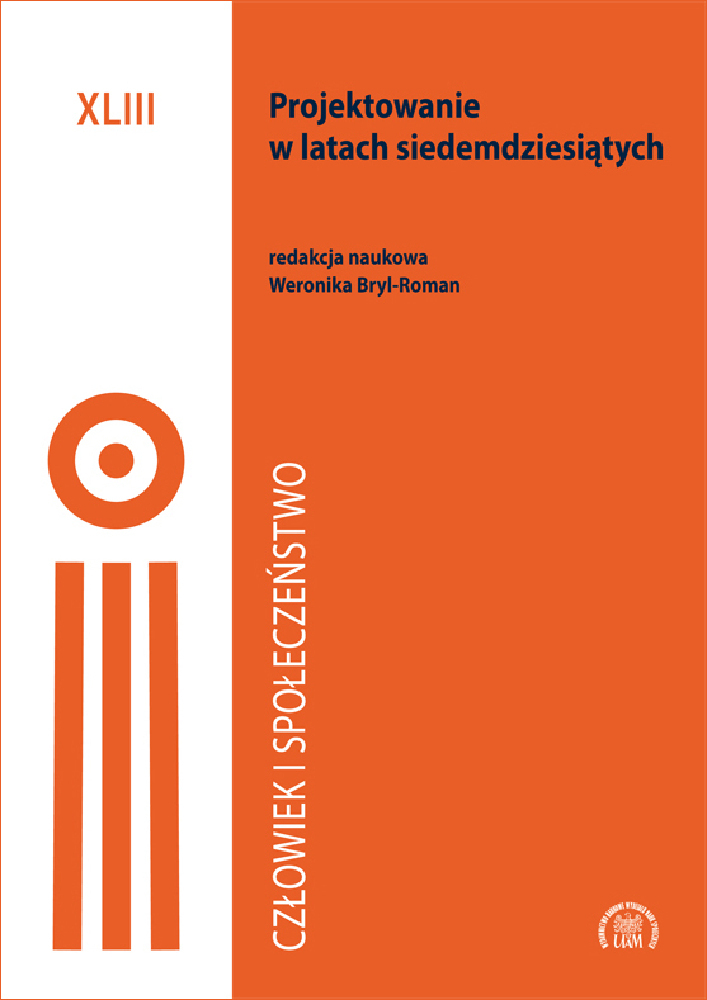Abstrakt
Irma Kozina, O czym mówią kreski i kropki? Narracja o pewnych działaniach artystycznych w Polsce lat 70. XX w. [What do „Lines and dots” reveal? A concise narrative about some artistic activities in Poland of the 1970s], edited by W. Bryl-Roman, „Człowiek i Społeczeństwo” vol. XLIII: Projektowanie w latach 70. [Designing in the 1970s], Poznań 2017, pp. 63-76, Adam Mickiewicz University. Faculty of Social Sciences Press. ISSN 0239-3271.
Referring to Lacanian post-structural theories, the author seeks to interpret some artistic and architectural phenomena in Poland of the 1970s as a sort of ‚images’ that enable the interpreter the access to the unconscious unity of symbolic and real orders forming the contemporary picture of the not too distant past. Due to such strategies, the analysis of Władysław Nehrebecki’s animation.
movie „Lines and dots” reveals its ambiguous contents depending on the attitude of the interpreter who might take into consideration either formalist or symbolic meanings hidden in the film’s visual language. Scenes appearing in the animation movies quoted in the text (created by authors whose works were treated as secondary forms of artistic expression at the time of their inception) function
as cute comments of everyday life routine developed in Poland of the socialist era. They coincide with the same problems that would determine the post-war housing construction restricted by the production capacities of precast concrete plants, they illustrate the realm in which artists are notoriously confronted with the limitations imposed on them by political ideologies and economic backwardness of their country. Despite all the external implications some artists, including the animation movie maker Julian Antoniszczak (the author of prominent non camera movie productions, along with „The way the miniature dachshund works” or „A Hard-Core Engaged Film”), managed to create works of art that have preserved their poignancy or enchantment, both: for the older generations (rapacious to confront the pictorial representation with the memories from the experienced past) as well as for the younger ones (attracted by the films’ formal beauty or by their – allegedly non-realistic – sense of humour).
Bibliografia
Foster H., Powrót Realnego, w: Perspektywy współczesnej historii sztuki. Antologia przekładów „H. Questiones”, red. M. Bryl, P. Juszkiewicz, P. Piotrowski, W. Suchocki, Wyd. Uniwersytetu Adama Mickiewicza, Poznań 2009.
Katalog mebli i urządzeń wnętrz mieszkalnych. Wzornik-Poradnik dla klientów i zakładów usługowych, t. 1, Stowarzyszenie Inżynierów i Techników Mechaników, Gliwice 1968.
Ruse M., Is science sexist? And Other Problems in the Biomedical Sciences, The University of Western Ontario, series in philosophy of science, vol. 17, Dordrecht–Boston–London 1981.
Thomas F., Ollie Johnston, the Illusion of Life: Disney Animation, Hyperion Books, New York 1981.
Licencja
1. W momencie złożenia pracy celem rozpoczęcia postępowania w sprawie publikacji, Licencjodawca, zwany dalej Autorem, akceptuje wszystkie zasady umieszczone na stronie internetowej czasopisma “Człowiek i Społeczeństwo”, udzielając Licencjobiorcy, zwanego dalej Wydawcą, niewyłącznej i nieodpłatnej licencji na korzystanie z Utworu. Licencja zakłada tym samym brak ograniczeń terytorialnych, czasowych oraz ilościowych na następujących polach eksploatacji (art. 50 ustawy z dnia 4 lutego 1994 r. o prawie autorskim i prawach pokrewnych):
a. utrwalanie Utworu;
b. zwielokrotnienie Utworu drukiem i w wersji cyfrowej;
c. wprowadzenie do obrotu, użyczenie lub najem oryginału/zwielokrotnionych egzemplarzy Utworu;
d. publiczne wykonanie, wystawienie, wyświetlenie, odtworzenie oraz nadawanie i reemitowanie, a także publiczne udostępnianie Utworu w taki sposób, aby każdy mógł mieć do niego dostęp w miejscu i w czasie przez siebie wybranym;
e. włączenie Utworu w skład utworu zbiorowego;
f. wprowadzenie Utworu w postaci elektronicznej na platformy elektroniczne lub inne wprowadzenie Utworu w postaci elektronicznej do Internetu, Intranetu, Extranetu lub innej sieci;
g. rozpowszechnianie Utworu w wersji elektronicznej w Internecie, Intranecie, Extranecie lub innej sieci, w pracy zbiorowej, a także samodzielnie w formule Open Access w oparciu o licencję Creative Commons Uznanie autorstwa 4.0 Międzynarodowa Licencja Publiczna (CC BY 4.0), a także inną wersję językową tej licencji, lub którąkolwiek późniejszą wersję tej licencji.
2. Założenia licencji Creative Commons Uznanie autorstwa 4.0 Międzynarodowa Licencja Publiczna (CC BY 4.0), udzielają Wydawcy upoważnienia do kopiowania, zmieniania, rozprowadzania, przedstawiania i wykonywania Utworu jedynie pod warunkiem uznania autorstwa.
3. Wraz z dostarczeniem Utworu, Autor zobowiązuje się do wypełnienia, podpisania oraz odesłania skanu umowy
